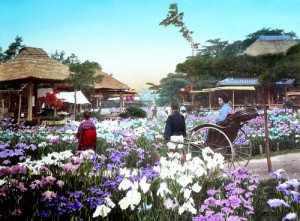We went to the Hirishoge exhibition here in Rome some time ago, and very impressive it was too, but I don’t remember seeing this particular woodcut.

I’ve in fact only just come across it, on Flickr, where there is this fascinating commentary:
In the village of Horikiri in suburban Edo, gardeners grew a year-round variety of flowers and were particularly famous for the iris shown here, “hanashobu,” well suited to this swampy land. In this print Hiroshige has shown three, almost-life-size, detailed specimens of the nineteenth-century hanashobu hybrids and in the distance, sightseers from Edo are admiring the blossoms. In the 1870’s the cultivation of hanashobu had begun to spread rapidly in Europe and America and the developed into a booming export market for the gardeners of Horikiri. The Horikiri plantations began to wane in the 1920’s and eventually turned over to wartime food production. After the war, one of them was revived and is now a public park, particularly popular in May when the flowers are in bloom.
The Horikiri Iris Garden looked like this in 1890:

And it looks like this now:

There’s also a clip about Horikiri on youtube. Which led me to a clip on the Giardino dell’Iris in Florence. This has been going since 1954, but the flower has been the symbol of the city since 1251. And a symbol of much else besides.
Well, that’s all great fun, of course, but where’s the agrobiodiversity angle, I hear you ask. Irises are nice ornamentals and everything, but you can’t eat them, can you? Alas, perhaps surprisingly, despite its horticultural importance, Iris (and indeed the Iris family as a whole, apart from saffron) doesn’t seem to have much in the way of food and agriculture uses. The main one I can find is use of the rhizome as orris root.
Once important in western herbal medicine, it is now used mainly as a fixative and base note in perfumery, as well as an ingredient in many brands of gin (perhaps most famously in Bombay Sapphire gin).
Tuscany is a major producer, or was in the 1930s, when the following was written.
The planting of the Orris root in Tuscany — locally known as ‘giaggiolo’ — is a matter of great importance. When the Iris begins to grow, the ground is carefully and systematically weeded, this being chiefly done by women, who traverse the rows of the plants barefoot, hoeing up the weeds; whole families of peasants work together at this, and in the subsequent collection, trimming and drying of the roots.
I can’t get a clear idea of the current significance of the crop from the internet, but here’s an excerpt from the entry on Iris florentina in Perennials of the Shakespeare Garden:
They are gathered in August, peeled, and dried by solar heat. The larger sections are replanted. The peasants divide the drug into several grades, as selected, sorts, raspings, powder, and that made into orris peas.
So right now is the time to explore the area between Florence and Siena if you’re interested in watching the orris root harvest. Maybe I’ll give it a go.